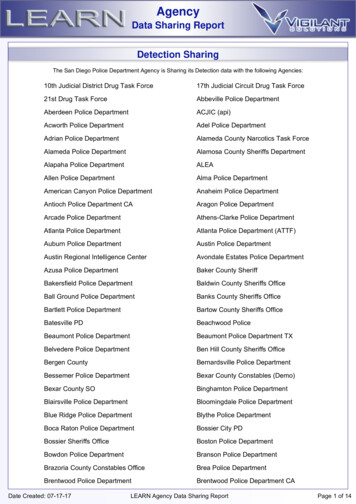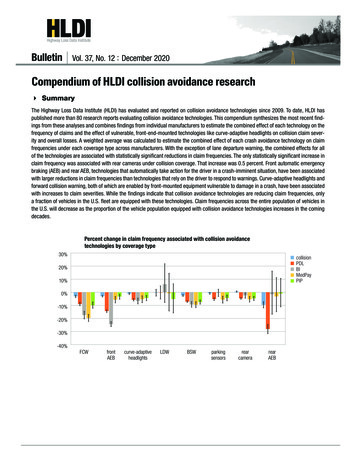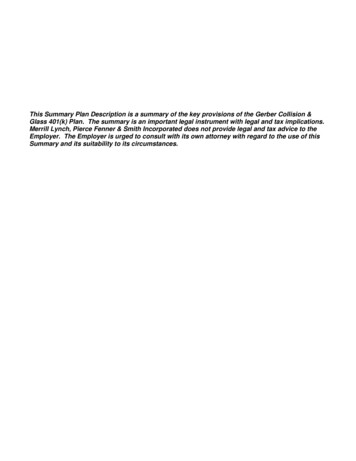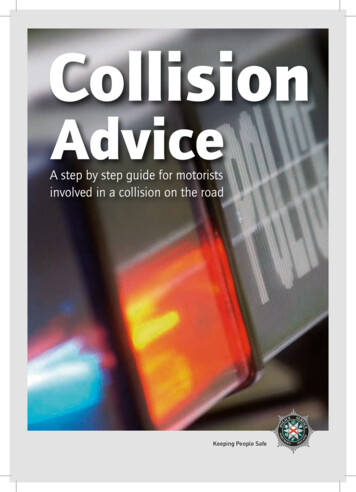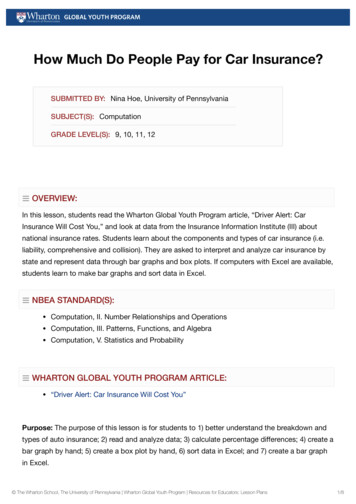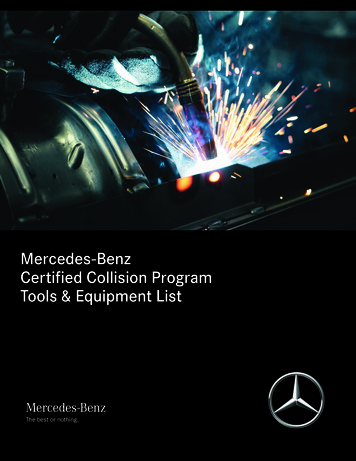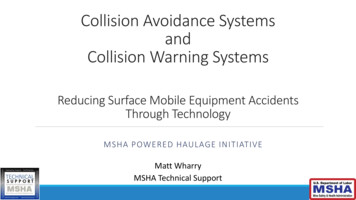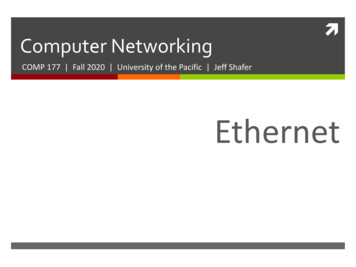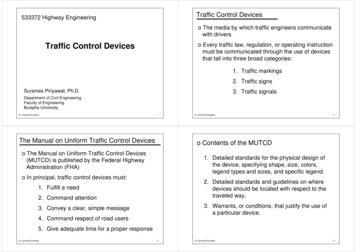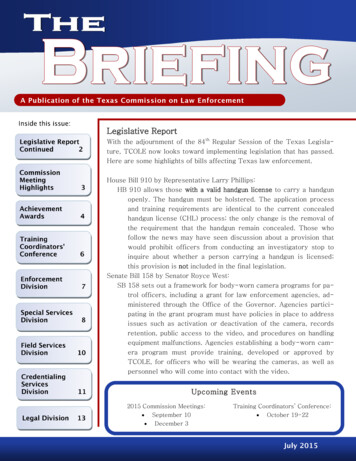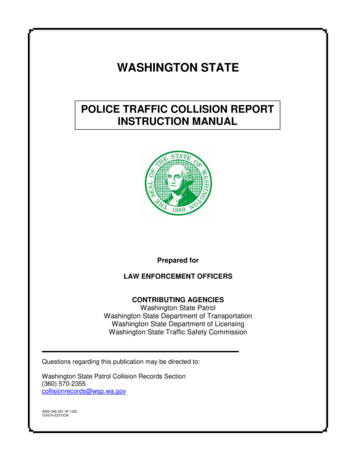
Transcription
WASHINGTON STATEPOLICE TRAFFIC COLLISION REPORTINSTRUCTION MANUALPrepared forLAW ENFORCEMENT OFFICERSCONTRIBUTING AGENCIESWashington State PatrolWashington State Department of TransportationWashington State Department of LicensingWashington State Traffic Safety CommissionQuestions regarding this publication may be directed to:Washington State Patrol Collision Records Section(360) 570-2355collisionrecords@wsp.wa.gov3000-345-221 (R 1/20)TENTH EDITION
THIS PAGE IS INTENTIONALLY BLANK
Police Traffic Collision Report Manual(10th Edition)Table of ContentsCHAPTER 1I.II.PURPOSE . 1-1GENERAL INSTRUCTIONS. 1-1CHAPTER 2I.II.III.IV.V.LOCATION, DATE, AND TIME. 3-1GENERAL INSTRUCTIONS. 3-1TOTAL NUMBER OF UNITS . 3-1OBJECT STRUCK. 3-1DATE AND TIME INFORMATION . 3-1LOCATION INFORMATION . 3-2A.B.C.D.E.F.G.H.I.J.K.L.M.CHAPTER 4I.II.REPORT IDENTIFIERS . 2-1GENERAL INSTRUCTIONS. 2-1REPORT NUMBER . 2-1CASE NUMBER . 2-1LOCAL AGENCY CODING . 2-1PAGE ORDER . 2-1CHAPTER 3I.II.III.IV.V.INTRODUCTION. 1-1ROADWAY TYPE . 3-2COLLISION INCIDENT TYPES. 3-3TRIBAL RESERVATIONS. 3-3COUNTY NUMBER . 3-3MILES AND DIRECTION . 3-3OUTSIDE AND INSIDE CITY LIMITS . 3-3CITY NUMBER . 3-3INTERSECTION . 3-4NON-INTERSECTION . 3-4PRIMARY TRAFFICWAY. 3-4BLOCK NUMBER AND MILEPOST . 3-5DISTANCE AND DIRECTION . 3-5REFERENCE OR CROSS STREET . 3-5UNIT INFORMATION. 4-1GENERAL INSTRUCTIONS. 4-1UNIT INFORMATION . 4-1A.B.UNIT 01 . 4-1UNIT 02 . 4-1Police Traffic CollisionReport Manual (January 2020)Table of Contentsi-i
III.FURTHER UNIT INFORMATION . 4-2A.B.C.D.E.F.G.H.I.J.K.L.M.N.CHAPTER 5I.II.III.SIDE CODING . 7-1GENERAL INSTRUCTIONS. 7-1LEFT SIDE CODING . 7-1A.B.C.i-iiVEHICLE INFORMATION . 6-1GENERAL INSTRUCTIONS. 6-1LICENSE PLATE. 6-1STATE. 6-1VEHICLE IDENTIFICATION NUMBER (VIN) . 6-1TRAILER INFORMATION . 6-1VEHICLE YEAR . 6-2VEHICLE MAKE . 6-2MODEL . 6-2STYLE . 6-2VEHICLE TOWED . 6-2TOWED BY . 6-2GOVERNMENT VEHICLE. 6-2REGISTERED OWNER INFORMATION . 6-3DAMAGE DIAGRAM . 6-3INSURANCE INFORMATION . 6-3VEHICLE LEGALLY STANDING . 6-3CITATION NUMBER . 6-4CHARGE . 6-4CHAPTER 7I.II.INJURY CODING. 5-1GENERAL INSTRUCTIONS. 5-1INJURY CLASS. 5-1NATURE OF INJURY . 5-2CHAPTER .XVI.XVII.XVIII.DAMAGE THRESHOLD. 4-2PHONE NUMBER . 4-2LAST NAME, FIRST NAME, AND MIDDLE INITIAL. 4-2STREET (NEW ADDRESS) . 4-2CITY, STATE, AND ZIP CODE . 4-3COMMERCIAL DRIVER’S LICENSE (CDL) . 4-3IGNITION INTERLOCK REQUIRED . 4-3IGNITION INTERLOCK PRESENT . 4-3MEDICALLY TRANSPORTED . 4-3DRIVER’S LICENSE AND STATE . 4-3SEX . 4-3DATE OF BIRTH. 4-4ON DUTY. 4-4COLLISION STATUS . 4-4AIRBAG . 4-5RESTRAINT SYSTEMS . 4-5EJECTION . 4-5HELMET USE. 4-6COLLISION SCENE . 7-1HAZARDOUS MATERIALS . 7-5TRAFFIC CONTROL . 7-5Table of ContentsPolice Traffic CollisionReport Manual (January 2020)
D.E.F.G.H.I.J.K.III.POSTED SPEED . 7-6TYPE OF ROADWAY . 7-6ROADWAY SURFACE TYPE . 7-6COMMERCIAL VEHICLE CLASSIFICATION . 7-7PEDESTRIAN OR PEDALCYCLIST . 7-7PEDESTRIAN OR PEDALCYCLIST CLOTHING VISIBILITY . 7-8PEDESTRIAN ACTION . 7-8PEDALCYCLIST ACTION. 7-9RIGHT SIDE CODING. 7-10A.B.C.D.E.F.G.H.I.CONTRIBUTING CIRCUMSTANCES . 7-10VEHICLE ACTIONS. 7-12VEHICLE CONDITION . 7-13DIRECTION OF MOVEMENT . 7-14EMERGENCY VEHICLE USE . 7-15UNIT ASSESSMENT . 7-15DRE ASSESSMENT REQUESTED . 7-16ALCOHOL RESULT. 7-16ACTUAL ALCOHOL RESULTS IN 100’S . 7-16CHAPTER 8I.II.OFFICER INFORMATION . 8-1GENERAL INSTRUCTIONS. 8-1OFFICER INFORMATION . 8-1CHAPTER 9I.II.III.IV.V.VI.PASSENGER AND WITNESS INFORMATION . 9-1GENERAL INSTRUCTIONS. 9-1PASSENGER DEFINITION . 9-1WITNESS . 9-1PERSON INFORMATION . 9-1BUS PASSENGERS . 9-2STATUS CODING . 9-21.2.3.4.5.6.7.STATUS PEDESTRIAN/PEDALCYCLIST . 9-2SEAT POSITION . 9-3AIRBAG . 9-4RESTRAINT SYSTEMS . 9-4EJECTION . 9-4HELMET USE . 9-5INJURY CLASS . 9-5CHAPTER 10I.II.III.GENERAL INSTRUCTIONS. 10-1DIAGRAM . 10-1SCENE NOT OBSERVED . 10-2CHAPTER 11I.II.III.IV.DIAGRAM . 10-1NARRATIVE INFORMATION . 11-1GENERAL INSTRUCTIONS. 11-1NARRATIVE INFORMATION . 11-1EXPANDED NARRATIVES . 11-3CASE FILE ATTACHMENTS . 11-3Police Traffic CollisionReport Manual (January 2020)Table of Contentsi-iii
CHAPTER 12I.II.GENERAL INSTRUCTIONS . 12-1AFFIDAVIT INFORMATION . 12-2CHAPTER 13I.II.III.IV.COUNTRIES . 17-1PROVINCES . 17-1STATES . 17-1TERRITORIES . 17-2CITY NUMBERS . 17-2COUNTY NUMBERS . 17-5REVISED CODE OF WASHINGTON (RCW) . 17-6ROADWAY TYPES . 17-6TRUCK TYPES . 17-11WASHINGTON STATE TRIBES . 17-12A.B.i-ivAPPENDIX . 17-1ABBREVIATIONS . 17-1A.B.C.D.I.II.III.IV.V.VI.PROHIBITED INFORMATION . 16-1GENERAL INSTRUCTIONS . 16-1PROHIBITED INFORMATION . 16-1CHAPTER 17I.CORRECTIONS . 15-1GENERAL INSTRUCTIONS . 15-1PART B CORRECTIONS . 15-1SUPPLEMENTAL CORRECTIONS . 15-2CHAPTER 16I.II.COMMERCIAL MOTOR CARRIER . 14-1GENERAL INSTRUCTIONS . 14-1CRITERIA FOR COMMERCIAL MOTOR CARRIER . 14-1INTERSTATE AND INTRASTATE . 14-2UNIT NUMBER . 14-2USDOT AND ICC NUMBER . 14-2VEHICLE TYPE . 14-3CARGO BODY TYPE . 14-3CARRIER NAME AND ADDRESS . 14-3CARRIER NAME SOURCE . 14-4NUMBER OF AXLES . 14-4GROSS VEHICLE WEIGHT RATING (GVWR) . 14-4PLACARD . 14-5CHAPTER 15I.II.III.SUPPLEMENTAL INFORMATION . 13-1GENERAL INSTRUCTIONS . 13-1CORRECTION . 13-1COMMERCIAL MOTOR CARRIER . 13-1SUPPLEMENTAL . 13-1CHAPTER 14I.II.III.IV.V.VI.VII.VIII.IX.X.XI.XII.AFFIDAVIT INFORMATION . 12-1FEDERALLY RECOGNIZED TRIBES . 17-12NON-FEDERALLY RECOGNIZED TRIBES . 17-12Table of ContentsPolice Traffic CollisionReport Manual (January 2020)
Police Traffic Collision Report Manual(10th Edition)Chapter 1 – IntroductionTable of ContentsCHAPTER 1INTRODUCTION . 1-1I.PURPOSE . 1-1II.GENERAL INSTRUCTIONS . 1-1Police Traffic CollisionReport Manual (January 2020)Introductioni
THIS PAGE IS INTENTIONALLY BLANKiiIntroductionPolice Traffic CollisionReport Manual (January 2020)
CHAPTER 1INTRODUCTIONProcedure #:01.01.000Effective Date: January 2020Supersedes:Police Traffic Collision ReportManual (9th Edition), August 2014See Also: American National Standard(ANSI) 7th Edition; RCW 46.52.030Applies To:All Law Enforcement OfficersI. PURPOSEA.The manual is designed to assist police officers in completing Police Traffic CollisionReport (PTCR) forms on vehicle collisions required by Washington State laws. ThePTCR was developed for use by all police officers investigating vehicle collisions.1.II.If your agency uses Statewide Electronic Collision and Ticket Online Records(SECTOR) to report vehicle collisions, some of the information in this manualmay not apply. For further information on how to fill out collision reports viaSECTOR, reference the Sector User Manual available in SECTOR Client.B.The information made available by accurate collision investigation and reporting isinvaluable in developing programs to reduce the number and/or severity of vehiclecollisions. It provides a basis for developing proper traffic laws and ordinances, trafficsafety programs, and other collision prevention programs. This information is alsoessential when litigation arises from collisions.C.The vehicle laws require any law enforcement officer to report each vehicle collisionresulting in injury or death of any person, or damage to the property of any one personto an apparent extent of 1,000 or more. Reports shall be submitted to theWashington State Patrol Collision Records Section within 4 days after any accident perRevised Code of Washington (RCW) 46.52.030.D.If the collision does not meet the reporting requirements and/or occurs on privateproperty, it is at the discretion of the responding agency whether or not a PTCR iscompleted and filed. If the collision meets the reporting requirements and occurs onprivate property or an officer does not respond, the involved parties should be advisedto complete a Motor Vehicle Collision Report (VCR). The VCR can be obtained fromany local law enforcement agency or on the Washington State Patrol (WSP) web siteunder Collision Records & Reports at www.wsp.wa.gov.GENERAL INSTRUCTIONSA.Enter all information requested on the PTCR form to the best of your knowledge. If therequested information is unknown, not available, or not applicable, leave those fields ofthe report blank or use the appropriate codes for none, unknown, or other. Applicablecodes are available on the PTCR Overlay Sheet (click here for collisions prior to12/31/19 or here for collisions after 1/1/20). Do not enter dashes or lines.B.If there is more information available to enter than space provided on the PTCR form,abbreviate information such as charges, nature of injuries, address, etc.Police Traffic CollisionReport Manual (January 2020)IntroductionChapter 1-1
C.If the original PTCR form is unavailable, stamp or write the word “ORIGINAL” in coloron the copy at the top of the report to the right of the barcode. If stamping isnecessary, make sure the stamp does not obscure data on the PTCR form.D.The Collision Records Section only retains PTCR forms.1.E.F.Do not attach citations, impound forms, Driving Under the Influence (DUI) forms,photographs, public web maps, or witness statements to the PTCR form.To ensure accuracy of data when filling out the PTCR form:1.Clearly print letters and numbers.2.Use a black ball-point pen with a medium tip and press firmly.3.Include spaces between multiple last or first names. Use commas to separatelast and first names of registered owner, passenger, and witness names.4.Asterisks can only be used in the driver’s license number field.When approving PTCRs, approving officers should not mark the reports with largecheck marks, dark highlighters, or anything that will obstruct the data.Chapter 1-2IntroductionPolice Traffic CollisionReport Manual (January 2020)
Police Traffic Collision Report Manual(10th Edition)Chapter 2 – Report IdentifiersTable of ContentsCHAPTER 2REPORT IDENTIFIERS . 2-1I.GENERAL INSTRUCTIONS. 2-1II.REPORT NUMBER . 2-1III.CASE NUMBER . 2-1IV.LOCAL AGENCY CODING . 2-1V.PAGE ORDER . 2-1Police Traffic CollisionReport Manual (January 2020)Report Identifiersi
THIS PAGE IS INTENTIONALLY BLANKiiReport IdentifiersPolice Traffic CollisionReport Manual (January 2020)
CHAPTER 2REPORT IDENTIFIERSProcedure #:02.01.000Effective Date:Supersedes:Police Traffic Collision ReportManual (9th Edition), August 2014Applies To:All Law Enforcement OfficersSee Also: American National Standard(ANSI) D16 1-2007: Manual onClassification of Motor Vehicle TrafficAccidents, 7th EditionJanuary 2020I. GENERAL INSTRUCTIONSII.A.The collision report contains administrative information that, when completedaccurately and entirely, significantly reduces the need for report revisions.B.Part A of the PTCR form is required for every collision report and can only be usedonce for a single collision.C.To record more than 2 units involved in a collision, a Supplemental PTCR form mustbe completed. Refer to Chapter 13 Supplemental Information for specific instructionson how to fill out a Supplemental PTCR form.REPORT NUMBERA.The collision report number on Part A is a pre-printed number assigned by the State ofWashington and appears in the top right corner of the PTCR form. The officer mustwrite the pre-printed report number in the upper right corner of all subsequent pages.III. CASE NUMBERA.The case number is an optional field for entry.B.The case number is a local agency originating case number. If applicable to yourjurisdiction, enter the originating case number in the field provided.IV. LOCAL AGENCY CODINGA.The local agency coding is an optional field for entry.B.Local agencies can use this field to include other designations on the collision report,such as special location coding.V. PAGE ORDERA.Page numbers must be recorded on the bottom right corner of all pages, includingadditional attachments submitted to the Collision Records Section.1.PTCR forms must be submitted in the following order:Police Traffic CollisionReport Manual (January 2020)Report IdentifiersChapter 2-1
a.Part Ab.Part B(1)c.If you are submitting more than one Part B form, the form with thenarrative section filled out must come first.Supplemental(1)When submitting a Supplemental or a correction at a later date, thepage(s) should be numbered independently from the original report.(2)The page order of a Supplemental/correction should follow the sameorder as the original report.(a)(3)d.Pages such as a Microsoft Word document or a typed narrative thatis not included on Part B.Diagram(1)Chapter 2-2NOTE: You cannot use Part A as a Supplemental or correction.Additional Narratives(1)e.For example, when submitting 2 Supplemental pages, if thereis a Part B and a Supplemental, Part B should be numberedas page 1 and the Supplemental as page 2.Pages either hand-drawn on a sheet of paper or copied from adiagram tool not included on Part B.Report IdentifiersPolice Traffic CollisionReport Manual (January 2020)
Police Traffic Collision Report Manual(10th Edition)Chapter 3 – Location, Date, and TimeTable of ContentsCHAPTER 3LOCATION, DATE, AND TIME. 3-1I.GENERAL INSTRUCTIONS. 3-1II.TOTAL NUMBER OF UNITS . 3-1III.OBJECT STRUCK. 3-1IV.DATE AND TIME INFORMATION . 3-1V.LOCATION INFORMATION . 3-2A.B.C.D.E.F.G.H.I.J.K.L.M.ROADWAY TYPE . 3-2COLLISION INCIDENT TYPES. 3-3TRIBAL RESERVATIONS. 3-3COUNTY NUMBER . 3-3MILES AND DIRECTION . 3-3OUTSIDE AND INSIDE CITY LIMITS . 3-3CITY NUMBER . 3-3INTERSECTION . 3-4NON-INTERSECTION . 3-4PRIMARY TRAFFICWAY. 3-4BLOCK NUMBER AND MILEPOST . 3-5DISTANCE AND DIRECTION . 3-5REFERENCE OR CROSS STREET . 3-5Police Traffic CollisionReport Manual (January 2020)Location/Date/Timei
THIS PAGE IS INTENTIONALLY BLANKiiLocation/Date/TimePolice Traffic CollisionReport Manual (January 2020)
CHAPTER 3LOCATION, DATE, AND TIMEProcedure #:03.01.000Effective Date: January 2020Supersedes:Police Traffic Collision ReportManual (9th Edition), August 2014See Also: American National Standard(ANSI), 7th EditionApplies To:All Law Enforcement OfficersI. GENERAL INSTRUCTIONSA.II.Not applicable to this chapter.TOTAL NUMBER OF UNITSA.Enter the total numbe
The information made available by accurate collision investigation and reporting is invaluable in developing programs to reduce the number and/or severity of vehicle collisions. It provides a basis for developing proper traffic laws and ordinances, traffic safety programs, and other collision prevention programs. This information is also
